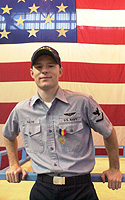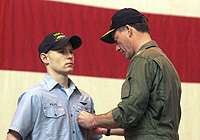Ed Fassnacht:
Ed was a 31-year-old lieutenant in the U.S. Navy when he lost his life in August 2000. A helicopter co-pilot, Ed and three comrades died when their Sea Dragon chopper had mechanical problems and crashed in the Gulf of Mexico while on a training mission near Corpus Christi. Ed was survived by his wife and two children, ages three and one.
Wednesday, March 7, 2001
Navy crash is blamed on copter
Navy probe clears crew in fatal August accident
The crew of a Navy helicopter that crashed in August heard a loud bang and attempted to fly back low and slow to shore as the aircraft fell apart, according to a Navy investigation released this week.
“All of the sudden there was an explosion and the next thing I remember was being in the water swimming,” said Airman Shawn R. Palyo. “I saw a piece of the aircraft and I crawled up on it.”
The investigation, completed in January, cleared the crew and support personnel of responsibility for the crash of the MH-53E Sea Dragon from Naval Air Station Corpus Christi, and laid the blame solely on a defect in the craft.
Lieutenant Shawn Jacobs, Lieutenant Edward Fassnacht, Petty Officer First Class Jeffrey Paschal, and Petty Officer Second Class David Rutherford, died in the crash on August 10, 2000. Petty Officer Third Class Jeremy Yaklin and Palyo were injured.
According to the report, the helicopter’s swashplate duplex bearing did not function properly and caused the crash. A swashplate bearing allows the rotor blades to spin above the helicopter.
The crash led to a grounding of Sea Dragons in the U.S. military, which have since been refitted with new bearings and a monitoring system that keeps track of the vibrations and heat emanating from the bearing, Navy officials said.
“We hope to ensure that the problem has been corrected and this won’t happen again,” said Mike Mauss, a public relations specialist with the Naval Air Force Atlantic Fleet.
On the day of the crash, the helicopter lifted off at 10:35 a.m., after being delayed twice in drills by other technical problems.
At about 10:46 a.m., the crew heard a bang overhead, the report said. The helicopter, which was flying between 150 and 300 feet, descended rapidly before the pilots were able to level off the craft and begin flying slowly back to land.
Strain on the engine.
The two survivors of the crash both reported hearing the strain on the engine as the pilots struggled to guide the craft, which was difficult to control, back to shore.
“I then heard a radio call but the only word I remember was ‘overtorque,’ ” Palyo told investigators in describing the force of the engine and rotor tearing the gears apart.
At about 10:51 a.m., a flash of fire was followed by an on-board explosion, the report said.
The two survivors, Yaklin and Palyo, who were sitting near the rear of the helicopter, said they did not remember anything until they were struggling to swim in the Gulf of Mexico.
Somehow the helicopter’s life raft had freed itself from the wreckage and partially inflated. Palyo, the less-injured of the two, dragged Yaklin into the raft and waited for help to arrive. Another MH-53E that had been involved in the exercises circled above them.
“I couldn’t move my legs and was in tremendous pain,” Yaklin said in his statement to military investigators. “I thought I was going to die…
“He (Palyo) managed to pull me into the raft and I could taste and smell fuel. There was a lot of blood in the raft and little pieces of Styrofoam.”
When the rescue helicopter arrived, Yaklin was the first to be lifted aboard.
He lost consciousness once he was lifted and woke up in the hospital. Palyo was hoisted aboard a different helicopter.
$20.5 million accident.
The cause of the $20.5 million accident was the swashplate gear, which gradually was being replaced by the Navy with a newer model, the report said.
The older model had been listed as the reason for two helicopter crashes in the 1990s, Navy investigators said.
The Navy reported that 49 percent of the MH-53s had the older model at the time of the Aug. 10 accident.
The Navy stated that the crew and support staff at Naval Air Station Corpus Christi followed all the proper maintenance checks and procedures leading up to the accident.
The aircraft had logged a little more than 10 hours of flight time since the bearings in the swashplate gear had been inspected. Inspections are required every 25 flight hours.
After the accident, the Navy grounded its fleet of 43 MH-53s, used for mine sweeping operations and 165 CH-53s, used by the Marines for transport.
After the bearings were replaced and the monitoring units installed, flights at the Naval Air Station resumed in December, said Commander. Bob Riehl, commanding officer of the Helicopter Mine Countermeasures Squadron 15, which has eight helicopters, 32 pilots and 80 enlisted crewmen.
“There was no hesitancy to get back,” Riehl said. “They all know the risks they are taking.”
Thursday, March 22, 2001
Navy bestows medal for crash heroism
Palyo risked fouled, shark-infested water to save a friend after copter crashed

‘I just consider myself really lucky,’ Palyo said. ‘I didn’t do anything that anybody else wouldn’t have done.’
Shawn Palyo remembers flying across the Gulf of Mexico in a MH-53E Sea Dragon, a sudden explosion, swimming in water filled with debris from the aircraft and pulling his buddy, Jeremy Yaklin, out of the water onto a partially inflated raft.
It wasn’t until the 20-year-old Petty Officer Third Class got to the hospital that he learned he drank salt water contaminated with fuel, that he had been precariously floating in water among sharks and that he had saved Yaklin’s life. They were the only survivors of the Aug. 10, 2000 crash that killed four.
“I don’t remember what I was thinking, really,” Palyo said. “I was really scared from it. You just don’t know what to think. I remember Jeremy saying he didn’t have any feelings in his legs. He had cuts everywhere.”
Admiral Robert J. Natter, commanding officer of the U.S. Atlantic Fleet, on Wednesday presented Palyo with the Navy and Marine Corps Medal, the highest award given for peacetime heroism. To be honored with the medal, a service member must risk his own life to save the life of another.

after the MH-53E Sea Dragon they were in crashed.
“I can’t imagine anyone doing a better job than he did in these circumstances,” said Natter, who visited sailors at Helicopter Mine Countermeasures Squadron 15 and Naval Station Ingleside.
Lieutenant Shawn Jacobs, Lieutenant Edward Fassnacht, Petty Officer First Class Jeffrey Paschal, and Petty Officer Second Class David Rutherford, died in the crash that officials said was caused by a defect in the aircraft.
According to an investigation report of the accident, the helicopter’s swashplate duplex bearing, which allows the rotor blades to spin above the helicopter, did not function properly.
The crash led to a grounding of the U.S. military’s Sea Dragons until they were refitted with new bearings and a monitoring system that keeps track of the vibrations and heat emanating from the bearing, Navy officials said.
“I have nightmares still and it’s still weird looking at them,” Palyo said, motioning toward one of the helicopters in the HM-15 hangar. “I would really like to fly again though.”
On the morning of the crash Yaklin and Palyo were sitting near the rear of the helicopter. Palyo said he remembers the explosion and then nothing else until he was struggling to swim in the Gulf of Mexico.
Palyo has said he crawled onto a piece of debris and that somehow the helicopter’s life raft had freed itself from the wreckage and partially inflated. Palyo spotted Yaklin in the water, swam 30 yards through jagged debris and dragged Yaklin back onto the raft and waited for rescue helicopters to hoist them to safety.
Yaklin, 20, a Petty Officer Third Class, still is recovering from his injuries that include nerve damage that has resulted in a loss of feeling and movement in his legs. He said he is awaiting a medical discharge and just recently began to regain movement in his right foot.
He said Palyo’s actions that day reflect the crew’s military training. “He did what anybody would have done. I would have done it for him.”
Palyo said he doesn’t consider his actions that day to be heroic.
“I just consider myself really lucky,” Palyo said. “I didn’t do anything that anybody else wouldn’t have done.”
FASSNACHT, EDWARD ROBERT
- LT US NAVY
- PERSIAN GULF
- DATE OF BIRTH: 10/30/1968
- DATE OF DEATH: 08/10/2000
- BURIED AT: SECTION 66 SITE 5882
- ARLINGTON NATIONAL CEMETERY
Michael Robert Patterson was born in Arlington and is the son of a former officer of the US Army. So it was no wonder that sooner or later his interests drew him to American history and especially to American military history. Many of his articles can be found on renowned portals like the New York Times, Washingtonpost or Wikipedia.
Reviewed by: Michael Howard
